Introduction
Web Evaluation
The widespread of internet technologies led that the web becoming virtually accessible to everyone. The statistics show that as of March 2011 there are approximately 298,002,705 sites responding online. All of those websites vary in their orientation, directivity, and the sphere in which they operate, but most of them share one common aspect –they provide information. At the present time, even schools students can design and publish a website online, which will be ranked and used just like others, and accordingly, fill such website with content. Thus, searching information online people come to sources from various origins in which two important groups of factors might emerge, those related to the content of the website, and those related to the representation of such information and the way it is navigated and retrieved. The inspection of those factors is the role of web evaluation. Web evaluation does not have a formal definition yet, where it can be defined as an assessment process through which it will be determined to which a website is easy to use and contains credible and reliable information. However, a definition was provided by the US Department of Health and Human Services which states that website evaluation can be characterized as “the act of determining a correct and comprehensive set of user requirements, ensuring that a website provides useful content that meets user expectations and setting usability goal” (Law, Qi and Buhalis 297).
The Purpose of the Paper
Following the aforementioned overview, the present report will attempt to evaluate the website of Hong Kong Disney Land, which start-up page in English is available at Web. The webpage will be evaluated based on qualitative and quantitative methods, at the end of which recommendations for improvement will be presented.
Web Evaluation Approaches
There are several approaches to the evaluation of WebPages, some of them are quantitative, i.e. use measures and criteria that can be quantified using indices and scores, while others are qualitative, i.e. the evaluation is based on non-quantifiable characteristics.
Qualitative
The qualitative approach used in this paper is focused on the evaluation of the content, rather than functionality. The method was developed by Jim Kapounand is currently proposed by Cornell University Library. The method is titled AAOCC (Accuracy, Authority, Objectivity, Currency, and Coverage), and which are the main criteria used to evaluate a website (CUL).
Accuracy
The authorship of the webpage is easy to establish, and as with most respectable commercial websites it is found under the link “About our Company”. The link redirects toward the company corporate website, which in addition to providing an overview of the author, provides other important corporate information, such as the vision of the company, its mission, and its corporate board. The author in that regard is the Hong Kong International Theme Park Limited (HKITP), which is a joint company owned by both the Hong Kong SAR Government and The Walt Disney Company (TWDC) (Hong Kong International Theme Parks). The contact possibilities provided on the start-up page lead to a contact form that can be filled out for inquiry purposes. In that regard, it can be stated that the webpage is accurate in presenting the information about its authors, and accordingly, a way for contact to verify the information presented there if necessary. It should be mentioned that there is no email provided on the contact page, rather than a free toll number for contact.
In terms of the information presented on the website, it can be stated that it is accurate considering the nature of such information. The purpose of the website is commercial, where it provides an opportunity for customers to learn about the park and make reservations online. On the one hand, the qualifications of the company as the author, including the Hong Kong government and TWDC, where the latter has the knowledge and the expertise necessary to provide such information, managing other Disney-themed parks worldwide. On the other hand, most of the information presented on the website reflects the direct activities of the company, rather than third-party initiatives, and thus, it can be stated that the information represented on the website is accurate.
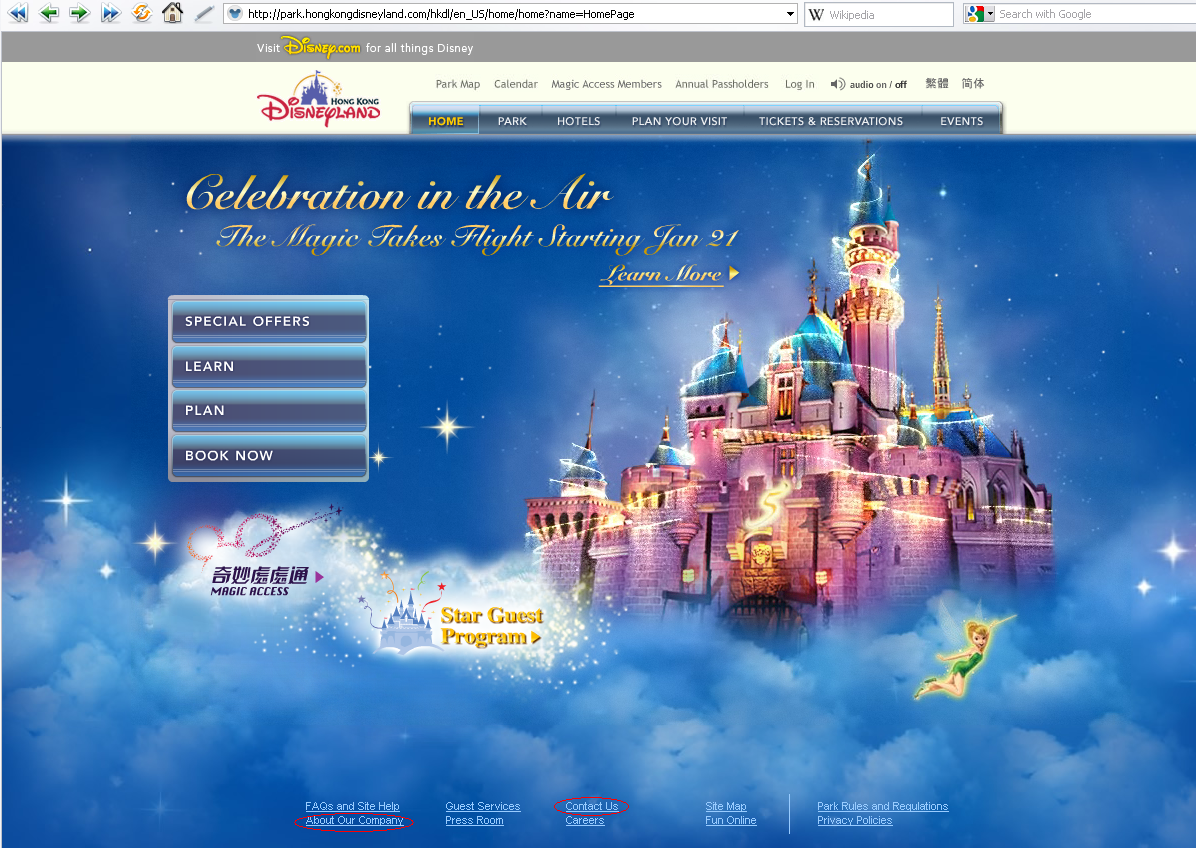
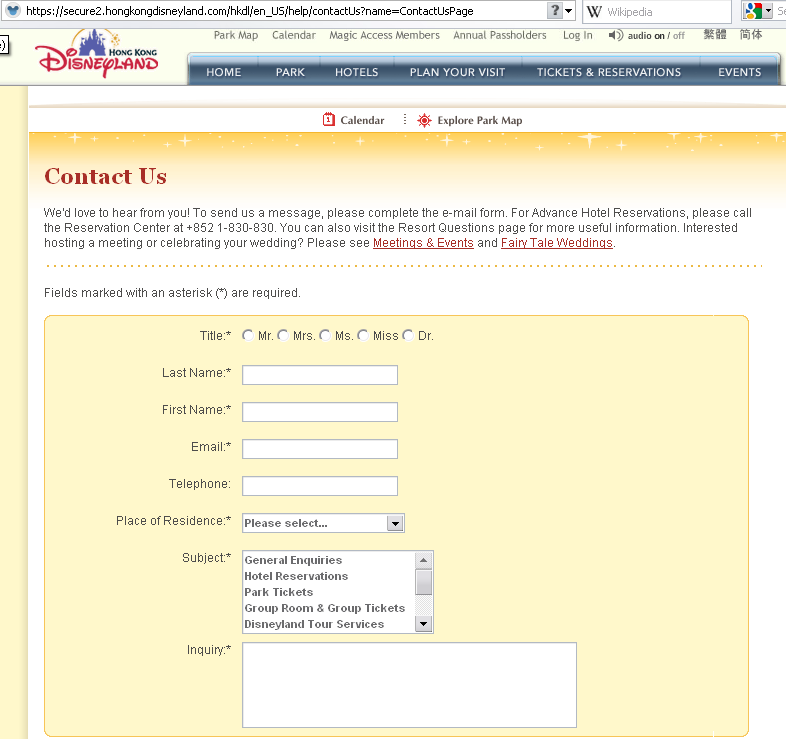
Authority
The authority criteria are related to outlining the credentials of authors. It is clear that from the website documentation that their author and webmaster are separated, although they are affiliated. The authors of the document are the joint venture between the Hong Kong government and TWDC, while the website is operated by “Buena Vista Internet Group, a California corporation, whose office is at 500 S Buena Vista St, Burbank, California, USA, and which is part of The Walt Disney Company group of companies” (Hong Kong International Theme Parks). Thus, it can be stated that the materials and their representation on the website are the full responsibility of its indicated owner.
The commercial purpose of the website is indicated through the “com” domain, which accordingly, indicate the nature of the qualifications of the authors. It should be noted that the credentials of the authors can be seen through the scale of the company which is marketed on the website. Although the involvement of the government in the company can be seen as a sufficient authority indicator, the indication of such facts as the number of employees employed, the investment made, and the contribution of the park to the incr4ease of the travelers in Hong Kong significantly add to the credentials of the authors. Thus, it can be stated that the author of the webpage has the authority and the qualification to publish information on the website.
Objectivity
The webpage is an internet representation of a commercial entity and thus, it certainly serves marketing purposes. Accordingly, the objectivity of such information can be largely disputed. Although at the present time the website did not contain third-party advertisements, the website’s terms of use document indicates the possibility of third-party links and advertisements being represented on the website, for which the company does not hold any responsibility. In that regard, it can be stated that the whole website is an advertisement, which is totally appropriate for a site of such nature and in such domain. Accordingly, it can be understood that the author of the website has a particular bias which is represented through the business component, i.e. making reservations, buying tickets, planning visits, etc. Nevertheless, it should be noted that most information on the website has little significance, in an academic context, and thus, its objectivity is unlikely to a part of the criteria in evaluation. Objectivity can be seen in that it is highly unlikely to find information on the website that will compromise the author of the website, even if such information exists. For example, the press release of the company does not contain information on problems that customers whose tickets were not acceptable, because the park was full (Fan). Thus, it can be concluded that the webpage is not objective in presenting its information, which is an appropriate practice for commercial websites, which main goal is profit.
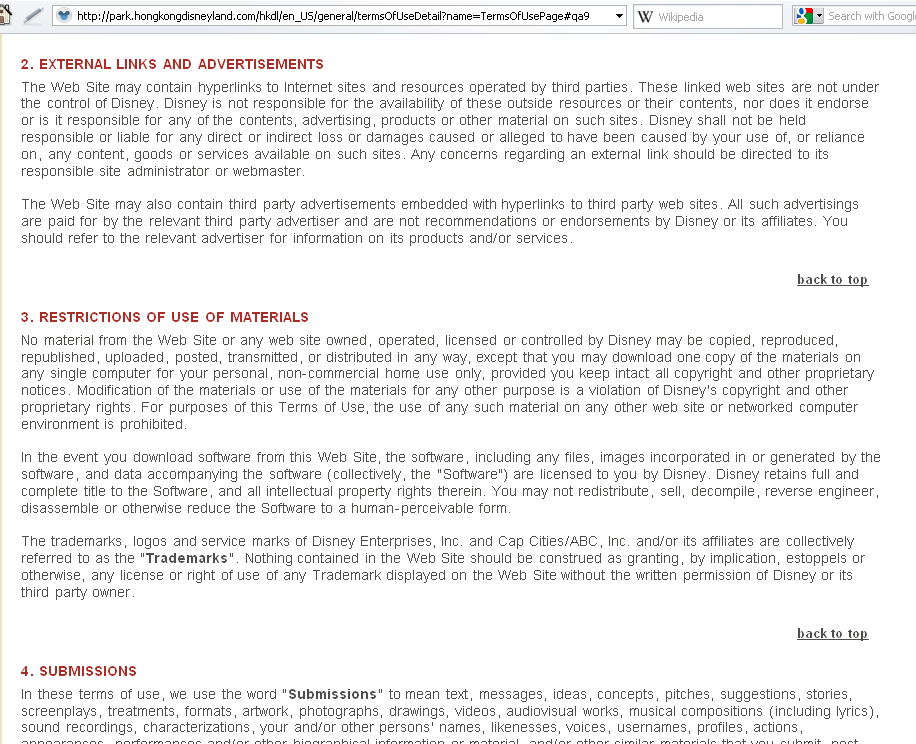
Currency
The website does not have an indication of the dates at which the website was created or when the last time the information was updated. The nature of the information in that matter might provide implications on the frequency of the updates on the webpage. In that regard, the only document that contains an explicit indication of its update date is the privacy policies of the website, updated at the 10th of March, 2011. Other aspects are implied to be up-to-date, as their currency falls within the interests of the author, e.g. the recent events associated with the park, the discounts, and the special offers. The date of the creation of the website in general can be assumed to be around the time the park was opened in 2005 (Hong Kong International Theme Parks). Such information was supported through an investigation of the websites information on NetCraft, a company providing “research data and analysis on many aspects of the Internet”, which stated that the website was first reported on October, 2005 (Netcraft). Any other more detailed information on the currency of the website is absent, and at the same time, no dead links were found during the investigation. Thus, it can be concluded that despite the fact that the website lacks an explicit indication of the currency of its information; such information can be safely assumed to be current, according to an analysis of its contents.
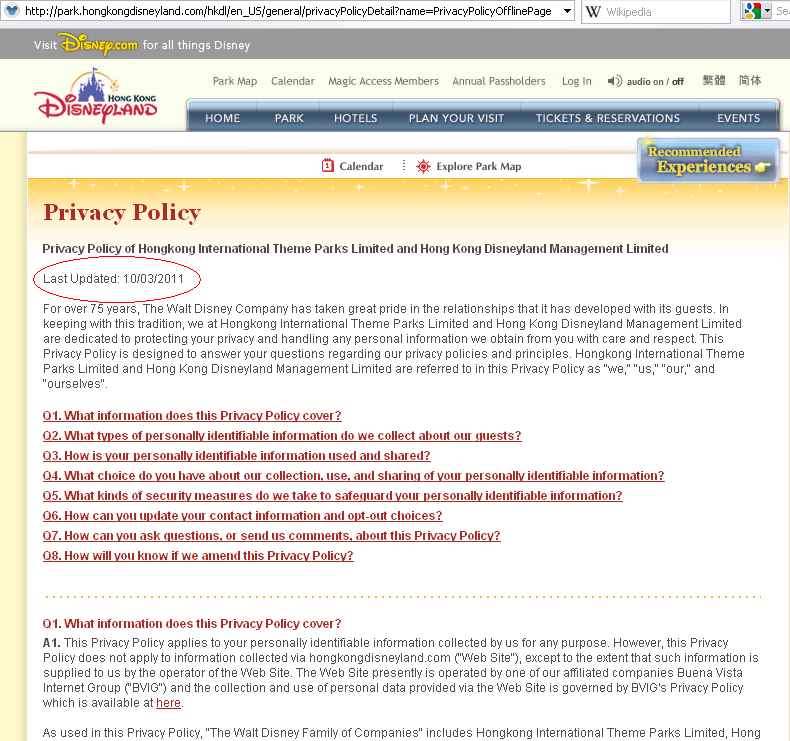
Coverage
The coverage aspect is related to the comprehensiveness of the information on the webpage. In that regard, it can be stated that there are no apparent gaps in the information for the purposes they serve. The majority of the information is factual, where the opinionated aspect is related mostly to the descriptive marketing side of commercial websites. Nevertheless, the factual part of information is almost completely authored by either Hong Kong International Theme Park Limited (HKITP) or by the parties incorporated in the venture. Accordingly, no external materials are mentioned on the website. The link that connects to the corporate website of the park however, might contain information from external resources, namely ion the press releases section. Such resources are mostly quotes of public figures, which are appropriately credited within the text. Other than that, the information on the website is published firsthand, and thus, no citations are required. The information on the website heavily relies on Adobe Flash on its representation, and thus, in case such software component is not installed on the browser, the user might have less than comprehensive experience from the information. In addition to textual information, the website provides interactive guides and tours which complement the information on the website. It should be noted that almost all websites are compatible with such software plug-in, and thus, only a small category of users might be affected. Such category might include the users of mobile devices from Apple e.g. IPod Touch, IPad, iPhone, which browsers do not support Adobe Flash (Raphael). Thus, it can be conclude that the information on the website is fairly comprehensive for its purpose.
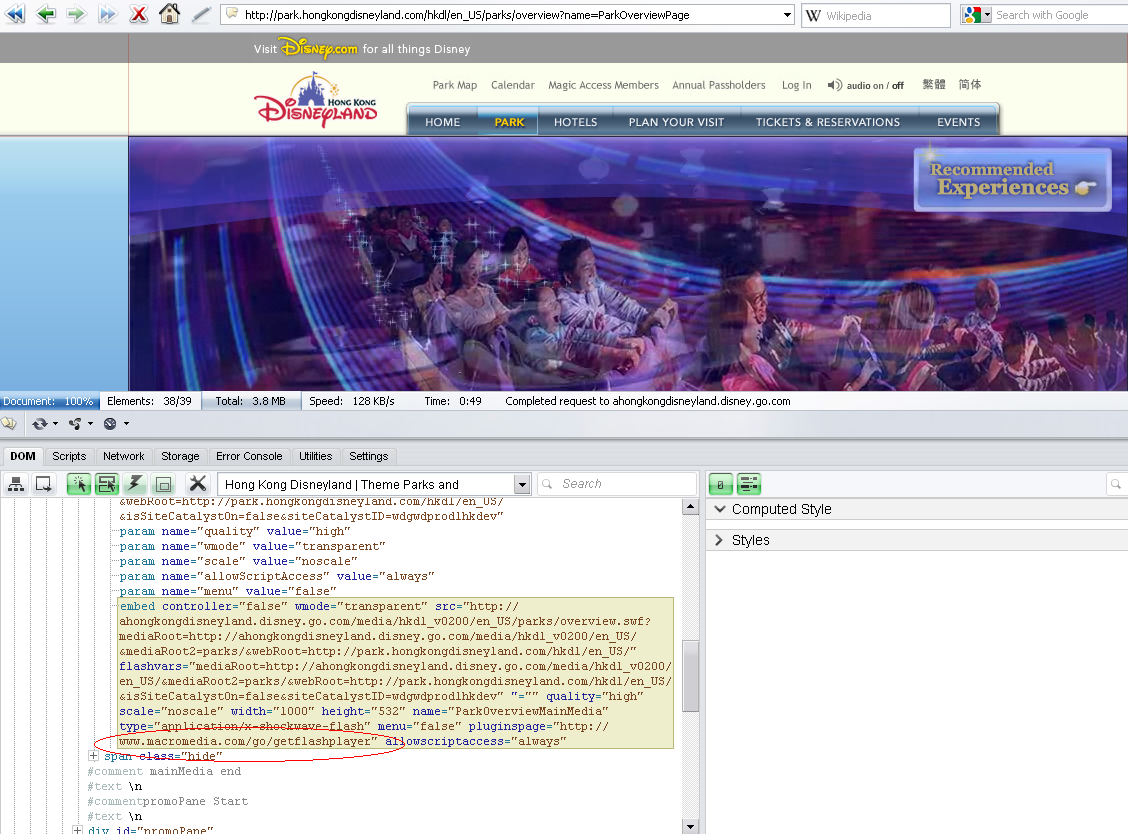
Quantitative
Overview
The quantitative approach to evaluating a website implies the usage of metrics and indices that can be quantified. In that regard, such approach implies several methods such as web content mining, web structure mining, web usage mining, and others. Most approaches imply analyzing logs, which can be hindered by the difficult to have access of such logs. Thus, the method chosen in this paper is web usage mining, which will be provided based on external third party software which will provide essential information for evaluation. The evaluation will be conducted through the site Alexa.com, a website that provides analytical information on web usage, through the installation of toolbars on the computers of their participants. Thus, such data mining technique can be paralleled to the use of surveys for data collection, which are compared in accordance with established indices (Alexa “About Alexa Internet”).
Findings
The main information important for the evaluation can be seen through the following facts (Alexa “Tokyo Disneyland “):
- 20% of the visitors come to the website through search engines.
- The users are mostly females, and browse from school and work, have no college or some college degree.
- The website is slower than 66% of the websites on the internet.
- The website is ranked the highest in Hong Kong, followed by Macao and the Philippines.
- 95% of the visitors stay on the starting homepage of the website.
- The highest percentage of websites visited before and after visiting the homepage of Hong Kong Disneyland are Yahoo and Facebook.
- 37% of visitors viewed a single webpage on the site, the highest among Disneyland Paris and Disneyland Tokyo.
- The average time spend on the website by users is 4.5 minutes, which is the lowest among Disneyland Paris and Disneyland Tokyo.
Thus, according to the aforementioned findings it can be stated that the use of the website and the behavior of visitors corresponds to its commercial nature. The majority of users do not browse the whole website, where the starting page provides sufficient information. Only two percent of the total numbers of visitors were visiting the corporate website of the website, and the only link followed form the website was Disney’s parent company website. The latter indicates that the usage pattern of the website is mostly restricted to the commercial aspects of the site, i.e. dates, events, schedules, etc. The time spend on the website indicates that no significance being placed on the authorship of the material. Comparing the use of the website to similar park themes, Hong Kong Disney land slightly lags behind. Accordingly, it might be assumed that the visitors have a predefined objective visiting the site, which might be explained through the description of the audience, i.e. females, with children. The general conclusion that can be made regarding the website is that its content corresponds to the profile and the goals of its target audience and their expectations. A comparison with similar websites revealed slight differences in favor of competitors, which do not change the general conclusion on the website.
Recommendations
The recommendations that can be made regarding the website can be divided into three points. The three points can be seen as follows:
- Indication of the currency of the website’s information.
- Changing the start-up page.
- Improving the speed and the compatibility of the website.
The currency of the website is related to the findings of the AAOCC evaluation. In that regard, a typical scenario is writing a report of the Hong Kong Disney Land in which the writer will not have the opportunity to prove the currency of the information found on the website. Thus, it will be recommended that the author of the website puts information that indicates when the website was created, a specific page was created, and the last time it was updated.
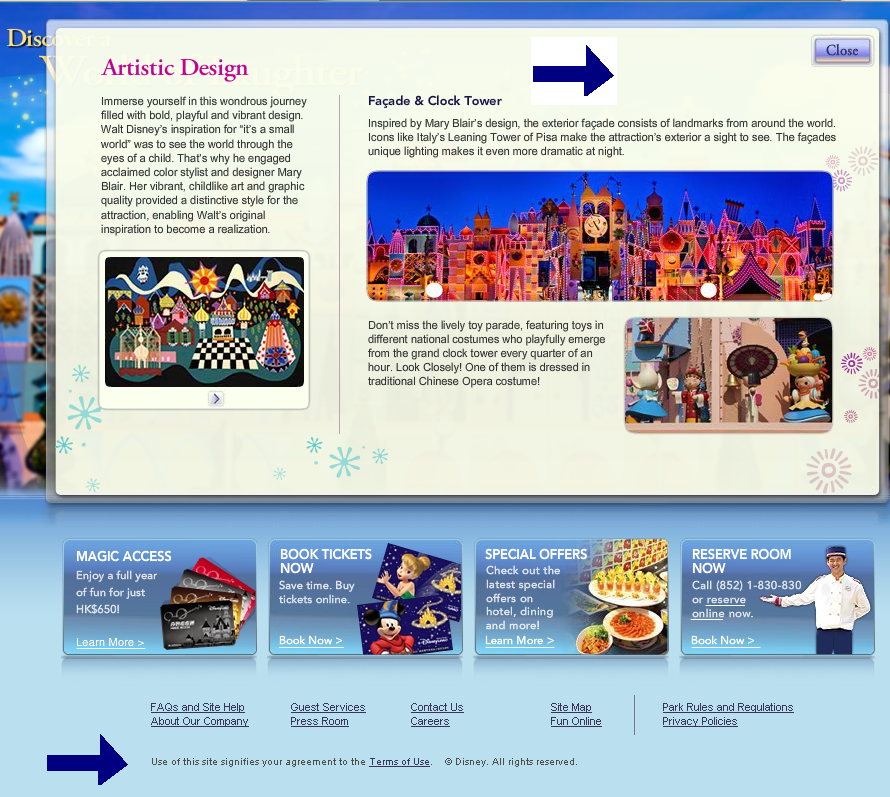
A change in the starting page might increase the efficiency of the navigation for the users. Identifying the typical pages to which the users navigate, it can be stated that it be easier if those pages were put right at front page of the site. A good example in that matter can be seen through the website of Disneyland Paris, in which the homepage opens right away on the booking options for visit planning. Considering the finding that the speed of loading is lower than 66% of WebPages online, it can be stated that such improvement might enhance the browsing experience for the users.
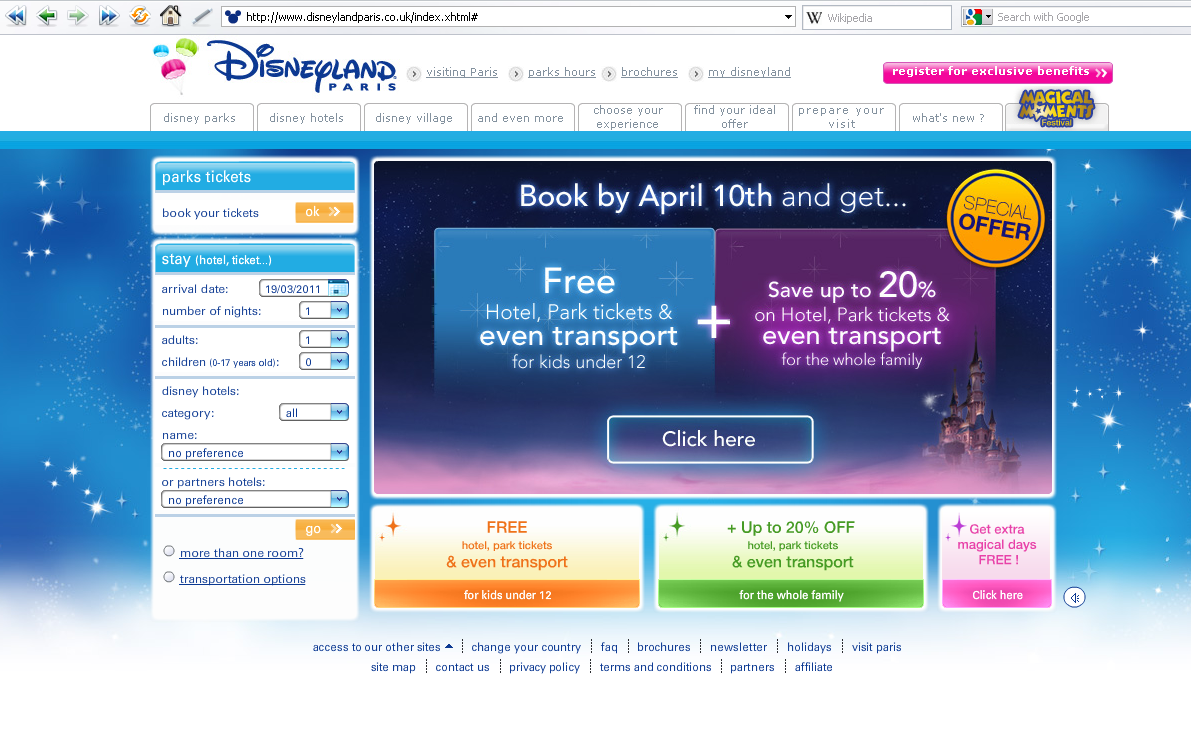
Finally, one area of improvement can be seen through the speed of loading pages. For many search engines the speed of the website’s engine is a considered as a factor in the rank of the page, as well as a factor in improving the user experience (McGee; Hopkins). Considering that that the website is significantly low in [age loading and considering the commercial nature of the website, it is important to increase the speed of the page loading, where it is argued that “delays under half a second impact business metrics” (McGee). One suggestion can be seen through using different techniques, e.g. Ajax, and reducing the components that the user downloads, especially if those components are remotely connected to users’ objectives on the website. An example can be seen through the elimination of Adobe flash from the website. On the one hand, such aspect will increase the compatibility of the webpage with more browsers, and on the other it will increase the load time for the page, without affecting the user experience. The Website for Disneyland Tokyo does not use Flash, it is 37% faster than Hong Kong Disneyland , and it is significantly higher in Alexa rank, 6,998 against 61,314 (Alexa “Tokyo Disneyland “).
Conclusion
The present paper provided a web evaluation for the website of the Hong Kong Disneyland. The evaluation used a qualitative approach in analyzing content, using AAOCC (Accuracy, Authority, Objectivity, Currency, and Coverage), and a quantitative approach, using data mining through reports from the website Alexa.com. The report found that generally the content of the website corresponds to the expectation of users and the purpose of the website, although lacking currency indicators. In terms of user experience some problems can be seen through the speed of page loading.The report recommends putting dates on the information of the website, changing the homepage, and increasing the load speed of the page.
Works Cited
Alexa. “About Alexa Internet”. 2011. Alexa Internet, Inc.
Alexa. “Tokyo Disneyland “. 2011. Alexa Internet, Inc. Web.
CUL. “Five Criteria for Evaluating Web Pages”. 2010. Cornell University Library. Web.
Fan, Maureen. “Disney Culture Shock”. 2006. The Standard. Web.
Hong Kong International Theme Parks. “Hong Kong Disneyland Resort”. 2011. Hong Kong International Theme Parks.
Hopkins, Aaron. “Optimizing Page Load Time”. n.d. Die.net.
Law, Rob, Shanshan Qi, and Dimitrios Buhalis. “Progress in Tourism Management: A Review of Website Evaluation in Tourism Research.” Tourism Management 31.3 (2010): 297-313. Print.
McGee, Matt. “It’s Official: Google Now Counts Site Speed as a Ranking Factor”. 2010. Third Door Media, Inc.
Netcraft. “Site Report for Park.Hongkongdisneyland.Com”. 2011. Netcraft. Web.
Raphael, JR. “Apple’s Ipad and the Flash Clash”. 2010. PC World.